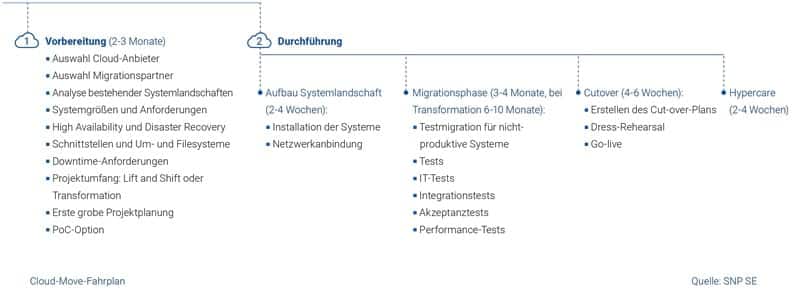RISE with SAP to the cloud - what companies need to consider


Although the classic SAP S/4HANA implementation is a combination of technical migration and business transformation, SAP customers usually approach these projects separately. For many, the move to the cloud remains purely an infrastructure issue. Too bad. Because the joint move to SAP S/4HANA and the cloud offers companies several advantages at once: a digitization of the IT landscape with high innovation potential, new components and shorter workflows. In addition, companies benefit from lower project costs, reduced project runtimes and fewer system failures during implementation.
According to SAPinsider's November 2021 Benchmark Report, SAP customers are primarily interested in the costs (46 percent) and SAP S/4HANA Cloud (39 percent). The other components of the Business Process Intelligence program, embedded tools, industry extensions, SAP BTP or Business Network, are currently of secondary interest. SAP users are using the migration to modernize their existing IT landscapes and at the same time prepare themselves for fully digitalized working environments.
Moreover, by switching to SAP S/4HANA and the cloud, they can combine two strategic transformation projects and reduce the overall effort. Project managers should take sufficient time for systematic planning and avoid acting in haste. What do companies need to consider when they decide to move their systems, data and applications to the SAP S/4HANA cloud?
The be-all and end-all: good planning
In order to develop an optimal strategy for SAP S/4HANA Cloud, it proves to be purposeful to first identify one's own drivers for the intended cloud use. Groups want to free themselves from the burden of a large, local data center and find a simpler, scalable alternative with which they can react more agilely to unexpected events or save costs.
In addition, companies need to get an overview of their current IT landscape: How large is the system, what data and applications are used? Can, may and should the entire system be outsourced or only certain parts? Based on this information, the project can be planned carefully and in line with the corporate strategy, and a decision can be made about the ideal cloud infrastructure and the suitable provider.
It is also important to find the right model for the provision of SAP S/4HANA Cloud as part of RISE with SAP. The software provider offers two models for this: the Private or Public Cloud Edition. The private cloud is of interest to most SAP user companies. It is primarily aimed at medium-sized and large companies that adapt SAP S/4HANA to their requirements and use extensions.
The well-known hyperscalers Amazon Web Services, Google, IBM and Microsoft operate the SAP systems. The public cloud is aimed at SAP customers who want to use SAP S/4HANA Cloud as standard. The cloud solution does not allow any customizing and is therefore particularly suitable for smaller SAP users with lower process complexity or for new companies. The advantage: They can achieve the lowest total cost of ownership (TCO).

Allow sufficient time for preparatory work
Ideally, targeted preparatory work should run in parallel: Numerous of our customer projects have shown that it pays to clean up the existing SAP landscape before migration. If the volume of data in the SAP systems can be reduced, less cloud storage will have to be rented later on, which can save a lot of money. It is also worth aiming for a reduction in non-productive systems such as development and quality assurance systems. This often hides further savings potential that can be leveraged more easily than or in addition to archiving in the productive system.
Less cost, less risk? Absolutely!
In a next step, companies should deal in detail with the question of how the migration to SAP S/4HANA Cloud can be realized technically. This fundamental decision has a significant impact on the success of the project. The use of transformation software and an automated procedure is recommended. This enables companies to migrate data particularly quickly and particularly securely and protects against long outages. This is because it is technically necessary to shut down business processes in the course of the changeover. It is particularly important for globally active or strongly customer-oriented companies with continuous operations to keep system downtimes to a minimum, because they quickly lead to immense costs.
A direct comparison shows how much the downtime can vary depending on the approach: A modern migration approach enables conversions of SAP systems in near-zero downtime and operations can continue largely without disruption. In contrast, the same data migration using a standard method would take significantly longer than a weekend, during which the IT system is unavailable!
The chosen software solution should also allow companies to look into the future: How will the planned changes affect my systems? If this can be simulated before the actual migration, costs and risks can be minimized and companies always retain control over the major project.
Learning from mistakes? Best not to make any first
When complex SAP systems and processes are moved to the SAP S/4HANA Cloud, serious errors sometimes occur. Those who deal with possible pitfalls in advance are clearly at an advantage. For example, it is important to deal with the interfaces in companies that ensure the exchange of information with internal and external communication partners. These digital interfaces, which often number several thousand, must be identified before a migration to SAP S/4HANA Cloud and converted or updated during the migration. This is the only way to ensure continuous exchange between employees and with partners, suppliers and customers.
Companies are also well advised to plan sufficient resources for test phases with SAP S/4HANA Cloud. In order to plan or document a migration properly and to ensure that balance sheets are presented unaltered, precise consultation with the auditor is required, especially when migrating financial systems.
If everything is considered, well planned and prepared, the move to SAP S/4HANA and the cloud can be carried out quickly and securely and the innovation potential of the new technology can be fully exploited.





